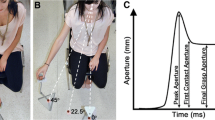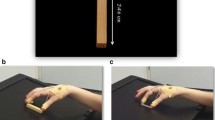Abstract
The reach-to-grasp movement is composed of a number of movement elements including hand transport, hand shaping, and grasping. These movement elements are featured in grasping when it is guided by vision, when it is guided by haptic input from the non-reaching hand or other body parts, and when it is guided by off-line perceptual (remembered) knowledge. An unanswered question is how is the reach-to-grasp movement achieved when all information about the target must be acquired by the grasping hand? The answer to this question was obtained by asking participants to reach for three randomly presented food items that varied in size: an orange slice, a small round donut ball, or a blueberry. In order to constrain the grasping pattern, participants were asked to pick up an item with the intention of placing it in the mouth. Thus, in the unsighted condition, participants did not know which item they were reaching for until they made haptic contact with it. Hand transport, shaping, and grasping were examined using frame-by-frame video analysis and linear kinematics. These measures showed that in unsighted reaching, hand transport first served to establish haptic contact between either the second or third digit and the target. After haptic identification of the target, the hand and/or grasping digits adjusted their trajectory, reshaped, and reoriented for grasping. A comparison of haptically guided grasping and visually guided grasping indicated that the two were very similar. This similarity is discussed in relation to contemporary ideas concerning the neural mechanisms that guide hand use.












Similar content being viewed by others
References
Arbib MA (1981) Perceptual structures and distributed motor control. In: Brooks VB (ed) Handbook of physiology, section 1, vol 2, part 2. William & Wukjubsm Baltimore, pp 1449–1480
Bernier PM, Grafton ST (2010) Human posterior parietal cortex flexibly determines reference frames for reaching based on sensory context. Neuron 68:776–788
Binkofski F, Buccino G, Posse S, Seitz RJ, Rizzolatti G, Freund H (1999) A fronto-parietal circuit for object manipulation in man: evidence from an fMRI-study. Eur J Neurosci 11:3276–3286
Castiello U, Bennett KM, Mucignat C (1993) The reach to grasp movement of blind subjects. Exp Brain Res 96:152–162
Castiello U, Bennett KM, Egan GF, Tochon-Danguy HJ, Kritikos A, Dunai J (2000) Human inferior parietal cortex ‘programs’ the action class of grasping. Cogn Syst Res 2:22–30
Chapman CS, Gallivan JP, Wood DK, Milne JL, Culham JC, Goodale MA (2010) Reaching for the unknown: multiple target encoding and real-time decision-making in a rapid reach task. Cognition 116:168–176
de Bruin N, Sacrey LA, Brown LA, Doan J, Whishaw IQ (2008) Visual guidance for hand advance but not hand withdrawal in a reach-to-eat task in adult humans: reaching is a composite movement. J Mot Behav 40:337–346
De Santis L, Spierer L, Clarke S, Murray MM (2007) Getting in touch: Segregated somatosensory what and where pathways in humans revealed by electrical neuroimaging. Neuroimage 37:890–903
Desmurget M, Prablanc C (1997) Postural control of three dimensional prehension movements. J Neurophysiol 77:452–464
Desmurget M, Prablanc C, Arzi M, Rossetti Y, Paulignan Y, Urquizar C (1996) Integrated control of hand transport and orientation during prehension movements. Exp Brain Res 110:265–278
Elliot JM, Connolly KJ (1984) A classification of manipulative hand movements. Dev Med Child Neurol 26:283–296
Fiehler K, Bannert MM, Bischoff M, Blecker C, Stark R, Vaitl D, Franz VH, Rosler F (2011) Working memory maintenance of grasp-target information in the human posterior parietal cortex. Neuroimage 54:2401–2411
Gentilucci M, Daprati E, Gangitano M, Saetti C, Toni I (1996) On orienting the hand to reach and grasp an object. NeuroReport 7:589–592
Gentilucci M, Caselli L, Secchi C (2003) Finger control in the tripod grasp. Exp Brain Res 149:351–360
Goodale MA, Milner AD (1992) Separate visual pathways for perception and action. Trends Neurosci 15:20–25
Goodale MA, Murphy KJ, Meenan J-P, Racicot CI, Nicholle DA (1993) Spared object perception but poor object-calibrated grasping in a patient with optic ataxia. Soc Neurosci Abstr 19:775
Goodale MA, Meenan JP, Bulthoff HH, Nicolle DA, Murphy KJ, Racicot CI (1994) Separate neural pathways for the visual analysis of object shape in perception and prehension. Curr Biol 4:604–610
Goodale MA, Westwood DA, Milner AD (2004) Two distinct modes of control for object-directed action. Prog Brain Res 144:131–144
Hu Y, Eagleson R, Goodale MA (1999) The effects of delay on the kinematics of grasping. Exp Brain Res 126:109–116
Iberall T, Bingham G, Arbib MA (1986) Opposition space as a structuring concept for the analysis of skilled hand movements. In: Heuer H, Fromm C (eds) Generation and modulation of actions patterns. Experimental Brain Research Series, vol 15. Springer, Berlin, pp 158–173
Jacobs S, Danielmeier C, Frey SH (2010) Human anterior intraparietal and ventral premotor cortices support representations of grasping with the hand or a novel tool. J Cogn Neurosci 22:259–2608
Jacobsen C, Sperling L (1976) Classification of the hand-grip: a preliminary study. J Occup Med 18:395–398
Jakobson LS, Goodale MA (1991) Factors affecting higher-order movement planning: a kinematic analysis of human prehension. Exp Brain Res 86:199–208
Jakobson LS, Archibald YM, Carey DP, Goodale MA (1991) A kinematic analysis of reaching and grasping movements in a patient recovering from optic ataxia. Neuropsychologia 29:309–803
Jeannerod M (1981) Intersegmental coordination during reaching at natural visual objects. In: Long J, Baddeley A (eds) Attention and performance. Erlbaum, Hillsdale, pp 153–168
Jeannerod M (1984) The timing of natural prehension movements. J Mot Behav 16:235–254
Jeannerod M (1986) The formation of finger grip during prehension. A cortically mediated visuomotor pattern. Behav Brain Res 19:99–116
Jeannerod M, Decety J, Michael F (1994) Impairment of grasping movements following bilateral posterior parietal lesion. Neuropsychologia 32:369–380
Jeannerod M, Paulignan Y, Weiss P (1998) Grasping an object: one movement, several components. Novartis Found Symp 218:16–20
Kapandji IA (1982) The physiology of the joints, vol 1. Upper Limb, 5th edn. Churchill Livingstone, Edinburgh
Lederman SJ, Klatzky RL (1998) The hand as a perceptual system. In: Connolly K (ed) The psychobiology of the hand. MacKeith Press, London, pp 16–35
MacKenzie CL, Iberall T (1994a) Prehension. In: MacKenzie CL, Iberall T (eds) The grasping hand. Elsevier/North Holland, Amsterdam, pp 15–46
MacKenzie CL, Iberall T (1994b) Prehension. In: MacKenzie CL, Iberall T (eds) The grasping hand. Elsevier/North Holland, Amsterdam, p 30
Mamassian P (1997) Prehension of objects oriented in three-dimensional space. Exp Brain Res 114:235–245
Monaco S, Kroliczak G, Quinlan DJ, Fattori P, Galletti C, Goodale MA, Culham JC (2010) Contribution of visual and proprioceptive information to the precision of reaching movements. Exp Brain Res 202:15–32
Murata A, Gallese V, Luppino G, Kaseda M, Sakata H (2000) Selectivity for the shape, size, and orientation of objects for grasping in neurons of monkey parietal area AIP. J Neurophysiol 83:2580–2601
Napier JR (1956) The prehensile movements of the human hand. J Bone Joint Surg Am 38-B:902–913
Paulignan Y, MacKenzie C, Marteniuk R, Jeannerod M (1991) Selective perturbation of visual input during prehension movements. 1. The effects of changing object position. Exp Brain Res 83:502–512
Pettypiece CE, Culham JC, Goodale MA (2009) Differential effects of delay upon visually and haptically guided grasping and perceptual judgements. Exp Brain Res 195:473–479
Pettypiece CE, Goodale MA, Culham JC (2010) Integration of haptic and visual size cues in perception and action revealed through cross-modal conflict. Exp Brain Res 201:863–873
Reed CL, Klatzky RL, Halgren E (2005) What vs. where in touch: an fMRI study. NeuroImage 25:718–726
Rizzolatti G, Luppino G, Matelli M (1998) The organization of the cortical motor system: new concepts. Electroencephalogr Clin Neurophysiol 106:283–296
Sacrey LA, Whishaw IQ (2010) Development of collection precedes targeted reaching: resting shapes of the hands and digits in 1–6-month-old human infants. Behav Brain Res 214:125–129
Sacrey LA, Alaverdashvili M, Whishaw IQ (2009) Similar hand shaping in reaching-for-food (skilled reaching) in rats and humans provides evidence of homology in release, collection, and manipulation movements. Behav Brain Res 204:153–161
Saling M, Mescheriakov S, Molokanova E, Stelmach GE, Berger M (1996) Grip reorganization during wrist transport: the influence of an altered aperture. Exp Brain Res 108:493–500
Sartori L, Staulino E, Castiello U (2011) How objects are grasped: the interplay between affordances and end-goals. PLoS ONE 6:e25203
Sathian K, Lacey S, Stilla R, Gibson GO, Deshpande G, Hu X, LaConte S, Glielmi C (2011) Dual pathways for haptic and visual perception of spatial and texture information. NeuroImage 57:462–475
Stelmach GE, Castiello U, Jeannerod M (1994) Orienting the finger opposition space during prehension movements. J Mot Behav 26:178–186
Timman D, Stelmach GE, Bloedel JR (1996) Grasping component alterations and limb transport. Exp Brain Res 108:486–492
Valyear KF, Chapman CS, Gallivan JP, Mark RS, Culham JC (2011) To use or to move: goal-set modulates priming when grasping real tools. Exp Brain Res 212:125–142
Whishaw IQ, Suchowersky O, Davis L, Sarna J, Metz G, Pellis SM (2002) Impairment of pronation, supination, and body coordination in reach-to-grasp tasks in human Parkinson’s disease (PD) reveals homology to deficits in animal models. Behav Brain Res 133:165–176
Whishaw IQ, Sacrey LA, Travis SG, Gholamrezaei G, Karl JM (2010a) The functional origins of speech-related hand gestures. Behav Brain Res 214:206–215
Whishaw IQ, Travis SG, Koppe SW, Sacrey LA, Gholamrezaei G, Gorny B (2010b) Hand shaping in the rat: conserved release and collection vs. flexible manipulation in overground walking, ladder rung walking, cylinder exploration, and skilled reaching. Behav Brain Res 206:21–31
Wing AM, Turton A (1986) Grasp size and accuracy in approach in reaching. J Mot Behav 18:245–260
Wong YJ, Whishaw IQ (2004) Precision grasps of children and young and old adults: individual differences in digit contact strategy, purchase pattern, and digit posture. Behav Brain Res 154:113–123
Acknowledgments
The authors would like to thank Jason Flindall for his valued technical assistance, Kateryna Morayko for assistance with frame counting, and two anonymous reviewers for their helpful comments on an earlier draft of this paper. This research was supported by the Natural Sciences and Engineering Research Council of Canada (JMK, LRS, IQW), Alberta Innovates-Health Solutions (JMK, LRS), and Canadian Institutes of Health Research (IQW).
Author information
Authors and Affiliations
Corresponding author
Rights and permissions
About this article
Cite this article
Karl, J.M., Sacrey, LA.R., Doan, J.B. et al. Hand shaping using hapsis resembles visually guided hand shaping. Exp Brain Res 219, 59–74 (2012). https://doi.org/10.1007/s00221-012-3067-y
Received:
Accepted:
Published:
Issue Date:
DOI: https://doi.org/10.1007/s00221-012-3067-y




